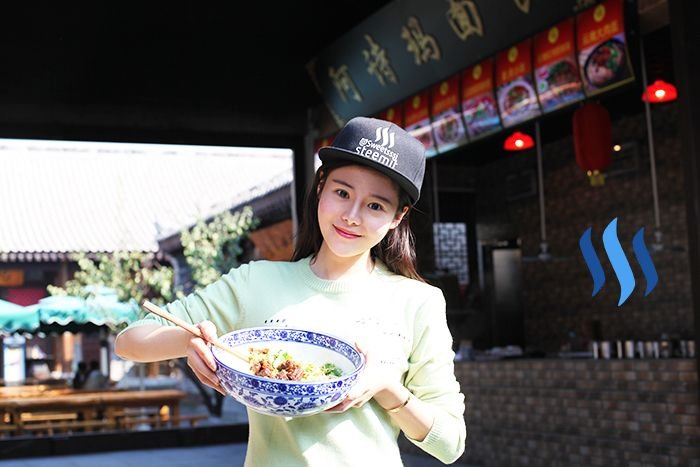Dear Steemit Friends:
Today I'd like to continue our journey through Bai Lu Yuan Studios in Guanzhong, where we'll explore and see some more traditional Chinese folk customs. First, let's take a look at the traditional food that Guanzhong has to offer. Due to the geography and location, there is very limited arable land in Guanzhong making it difficult to grow crops and other vegetation. As a result, people in this area have few opportunities to eat vegetables. The summer and autumn months are when the crops are harvested and so the people of Guanzhong tend to eat food made from wheat - noodles, dumplings, buns etc. Of course, in Guanzhong, there are a large variety of such foods, the three main types are noodles, fried pastry and steamed bread. In my last post about Bai lu Yuan studios (HERE) I introduced the fried pastry and steamed bread already, so today we'll take a look at the noodles!

In this very scenic and historical feeling court yard, we see many people holding and eating noodles from bowls larger than our heads!
These are special cake desserts made with glutinous rice and coarse grains. The red, yellow and purple make them very colourful and pleasant to the eye.
In terms of meat, people in Guanzhong eat mainly pork. So here, we have some stuffed pork buns.
These are little cakes made with black rice. It's naturally a little sweet.
I really like the bamboo tubes which the glutinous rice cakes are served in. It gives the desserts a real folk feeling.
These are Knife-Shaved Noodles, a speciality of Shaanxi. Knife shaved noodles have been popular in the northern provinces of China for quite some time and are still very popular to this day. The noodles are "shaved" by hand and together with the seasoning and condiments make for an absolutely delicious dish!
This is a stone hot pot with a soup base prepared for you to
Here we have the seasoning and condiments which we add ourselves to the hotpot.
1
First you put the condiments and seasoning into the pot then add the noodles afterwards. Here I've chosen a softer and lighter type of noodle which is my personal favourite.
1
There's even a cute little egg yolk inside!
Here we have some noodles with hot and numbing sauce.
The folks here are quite clever too, on the electric fan above, they've tied a ribbon to one of the blades. As the fan spins around, the ribbon also keeps the flies away from the food!
After the food, lets take a walk through the bustling streets.
There are lots of ancient style restaurants advertising with these very colourful flags just waving in the wind.
1
1
1
1
1
There's also lots of folk art on the walls everywhere I look.
1
1
1
Something that caught my attention was the banging noises. These are of course people making the New Years sticky glutinous rice cakes. It is custom at the end of the lunar year for the locals to eat these cakes. Everyone will use glutinous rice flour and then 'hit' them to get the flour in the right texture for steaming. Afterwards, these cakes are gifted as presents to family and friends. They are considered good omen for the coming year.
1
1
Since banging the flour requires a lot of banging, it creates a lot of noise attracting many customers. It's also a great way to create a positive atmosphere and vibe that sets a positive precedent for the coming year.
This beautiful object here is a pillar used to tie cows and horses. It's amazing that even such a simple tool has beautiful carvings on it.
1
Next up, lets take a look at the beautiful Guanzhong architecture.
1
1
1
1
This is the Baiyun Buddhist temple, it's got a clock and bell tower at the top. This was originally built in the Tang Dynasty.
1
1
1
1
There's even a bit of western influence here, I didn't think i'd find a church!
1
These are the villagers anti-fire contraptions.
At the top of these buildings are racks for sun drying various cloths.
Here's a view from the top of Bai Lu Yuan studios.
1
And that wraps up today's post about the Bai Lu Yuan studios and the wonderful traditions of the Guanzhong region. I hope you enjoyed the post, there will be more travel blogs coming real soon!
今天我想继续带大家走进白鹿原影视城, 了解更多关于关中民俗文化。首先,我们来探索一下关中吃的文化。由于受地理环境的影响,水田较少,蔬菜短缺,所以一般人家很少吃蔬菜。夏秋两季是农作物的收获,关中地区都以面食为主。关中面食的种类很多,主要分面条、锅饼和蒸馍三大类。锅饼和蒸馍在上一篇中有介绍过,今天我们就来看看关中的面食。
在古色古香的院子里,人们都喜欢捧着比脸还大的面碗,大口吃面。这是特产的糕点,拿糯米配上各种粗粮制作而成,红黄紫颜色非常好看。在肉食方面,关中地区以吃猪肉为主,这个就是猪肉馅的大包子。这个是黑米做的,吃起来味道甜甜的。我很喜欢包着糯米外面这一层竹筒,非常有民俗的味道。这个是宽宽的刀削面。刀削面是流行于北方的面食,它的面条全凭借手工的刀削而完成,再加上特制的调料,味道好极了。滚烫的清汤锅底,这一种面是要自己动手来烹饪的。这一盘是加入面里的小菜,是不是非常丰盛。接着再把这碗面下到锅里,接着滚烫的热水,把面和小菜煮熟,这是相对于其他面种相对口味清淡的面食了,也是我比较喜欢吃的一种面。面里还有可爱的小蛋黄。民族的智慧是强大的,这个电风扇绑上了丝带,丝带随着风扇转动,从而去赶走苍蝇。
吃饱了之后,跟我一起逛一逛美式街吧!各种古代饭店招揽生意的小旗子随风飘动,颜色鲜艳极了。墙上还时常看见充满艺术美感的民俗画。打年糕吸引了大家的注意,按照传统的习俗,每到农历年底,农村都有打年糕,吃年糕的习俗,家家户户用糯米磨成粉,之后打成年糕,之后会作为礼物,在过年去各家拜年的时候赠送,年糕在民间有年年登高的好彩头。最吸引人的还是打年糕的过程,人们喜欢打年糕的声音大,既能吸引来不少顾客,也增添热闹气氛,声音越大,就代表新的一年日子会过得红红火火。这个漂亮的小柱子,是用来拴牛和马的柱子,竟然柱子上也雕刻的这么漂亮。接下来带大家看看关中漂亮的建筑。这个是白云寺,配有钟鼓楼,原寺庙是建于唐代。这里也渗入西式的文化,一座教堂。村民们的防火工具。屋顶上晒太阳的布。白鹿原原上的风景。今天的白鹿原影视城之旅就到这里,之后还有更多有趣的故事想和你们分享。
